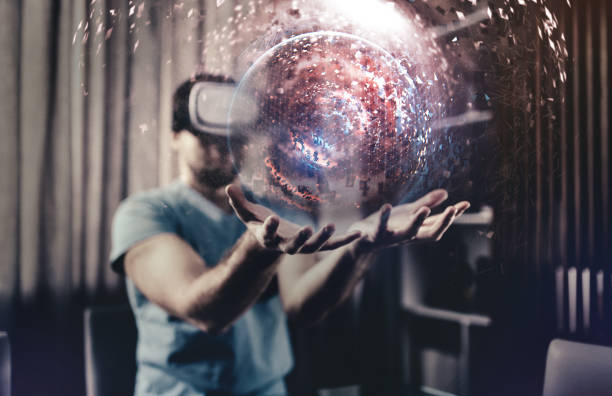Mean of Augmented Reality (AR)
The term “Augmented” refers to the process of improving or enhancing something. And by reality, I mean the truth. This refers to presenting the best side of anything that appears to be authentic. This is the kind of reality that keeps you in your world while moving your eyes forward. That is to say, you will be unable to distinguish between the real and virtual worlds. In simple terms, a virtual scene is generated by adding a virtual world to the surroundings around you that appear to be reality. To offer an example of Augmented Reality, imagine watching a match on TV where the match score appears on a screen in the middle of the pitch and changes in real-time as the match progresses, and the players are also playing at the same time. As you can see, the score you see on the field is virtual, but the players who are playing are real, thus you may call this Augmented Reality. Many know days technologies, such as smartphones, tablets, and Google Glass, already support augmented reality. AR devices use sensors, cameras, accelerometers, gyroscopes, digital compasses, GPS, CPUs, displays, and a variety of other components.

Different types of Working processes of Augmented Reality-
1. Motion Tracking
To give an example of motion tracking, when you turn on your phone’s camera, the gyroscope turns on as well. A gyroscope is a sensor that is found in every smartphone. The gyroscope detects your position and the angle to which your phone is degree your mobile is tilted. It helps in motion tracking.
2. Flat Surface
To reduce augmented reality, a flat surface is required. It will not operate if you work in a harsh environment. For it to install its model and communicate with you, you’ll need a level surface.
3. Light Estimation
The light surrounding you is measured by the sensor on your device. It generates a shadow of the sizes of augmented reality by doing so. As a result, this character appears to be real.
Uses of Augmented Reality-
- It aims to make the study of technology in schools as simple as possible. This makes it simple for pupils to comprehend. AR makes education even easier in today’s era of projectors, smart devices, and smart schools.
- AR is utilized as a model in this case. Previously, it was known how the project would seem once completed. It can be predicted how any residential or commercial project will look once it is completed using this method.
- This technology is employed in military operations. Everything on the ground is made aware to the soldiers by presenting them with a virtual ground. It has become an important aspect of army training in such a situation.
Mean of Virtual Reality (VR)-
Virtual Reality (VR) is a type of virtual reality that, as the name implies, is not real and is developed for amusement or imagination. In Virtual Reality, software based on computer technology (VR) is used to generate an artificial setting that has nothing to do with reality. That means, whatever conditions you can envision in Virtual Reality can be generated for you. Take, for example, Virtual Reality from 3D movies, in which you are entirely immersed in a virtual situation. A separate VR Headset device, known as HMD, has been created to experience this (Head Mounted Display). Some HMDs, such as the Oculus Quest, HTC VIVE, or Lenovo’s Mirage Solo With Daydream, are virtual reality headsets that you put on your eyes like glasses and then enter into the virtual world for any virtual experience you like. You can get in touch with me.

Types of Virtual Reality-
- Desktop VR
This technology represents a significant advancement in the realm of technology. Which computer desktop is utilized, and how the user is arranged to operate on the large screen? That is, the computer desktop’s small screen can be viewed on a large screen without the use of a large monitor. This technology is less expensive to manufacture than Immersive Virtual Reality.
- Projection VR
Virtual Reality (VR) is a type of virtual Multi-Computer Projection Theater is one that has numerous computers running at the same time. Pictures are projected on all of the theater’s walls. In the virtual world, this offers the impression of freedom of movement. Three walls are composed of the same material as the CAVE 3D Real Projection Theater. The first CAVE was created at the University of Illinois’ Electronic Visualization Laboratory.
- Immersive
The computer creates 3-D space in this case. Stereoscopic goggles are used for this. Information gathered from hand movements Gloves (certain types of gloves) have a small screen that displays a computer-generated image. This type of virtual reality is used to train astronauts and aircraft pilots.
- Augmented Reality
Augmented Reality is a type of Virtual Reality. The concept of Augmented Reality is to demonstrate that something must be added to the real world for it to become more real and entertaining. You know how to play appropriate background music with the story going on when you’re using a mobile, computer, or iPad, and the characters in the story feel right in front of you owing to Augmented Reality technology. You will notice that as you gaze at objects, information about those things is presented on the glasses’ glass. If you go to see the Taj Mahal and wear Google glasses in front of the architecture, you can learn about the Taj Mahal’s history and related information.
Benefits of VR-
Training-
In real life, numerous things are numerous things that are extremely dangerous to complete. In such a case, using Virtual Reality, the hazards associated with that work can be understood and mitigation steps done, considerably lowering the risk of injury.
Entertainment-
We can be ecstatic to experience what we can envision using Virtual Reality, whether it’s through a game or an incredible 3D VR movie that transports you to another universe.
Medical-
In medicine, virtual reality technology is utilized to instruct students in a virtual environment for any surgery or other related activity. So that new technology can be generated and the risk of failure in the task can be minimized.
Equipment used in virtual reality-
Head-mounted Displays (HMDs)- HMDs (Head-mounted Displays) are a type of display device that is worn on the helmet or the person’s head. When a small display is placed in front of one or both eyes, it is called optometry. HMDs are utilized in a variety of industries, including engineering and medicine, gaming, and aviation. It has a wide range of applications. Head-mounted displays (HMDs) with IMU are used in virtual reality headsets. A wearable display called an Optical Head-Mounted Display (OHMD) is also available. The user can see through it because it reflects the projected images.
Immersive Rooms- The term “immersive room” refers to a setting that has been designed with embedded or portable technology. Which creates or improves a fully immersive multimedia experience. Once inside the immersive chambers, one may wonder freely and get a close look at the real world. A virtual reality room that may be utilized for both VR and 3D visualization is available.
Datagloves- Datagloves is a device that allows you to enter data. So that humans and computers can communicate with each other. This gadget is worn on the hand as if it were a glove. In Virtual Reality, datagloves are frequently employed. Data is carried forward by robots using human hand movement.
Wands- This device has Motion Sensors and a TouchPoint. All of these buttons help the user interact with the virtual world.

